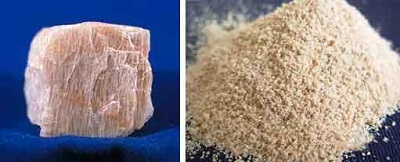Properties and Uses of Feldspar
“Feldspar” is the name of a large group of rock-forming silicate minerals that make up over 50% of Earth’s crust. They are found in igneous, metamorphic, and sedimentary rocks in all parts of the world. Feldspar minerals have very similar structures, chemical compositions, and physical properties. Common feldspars include orthoclase (KAlSi3O8), albite (NaAlSi3O8), and anorthite (CaAl2Si2O8).

Properties of Feldspar Minerals
Although there are many feldspar minerals, they all share a tight range of physical properties that are surprisingly consistent. Most of them exhibit two directions of perfect cleavage that intersect at or close to ninety degrees. An example of this type of cleavage can be seen in the accompanying photo.
Most feldspar minerals have a Mohs hardness of approximately 6 to 6.5 and a specific gravity between 2.5 and 2.8. They all have a vitreous luster that is often pearly on cleavage faces. The accompanying table shows the generalized physical properties of the feldspar mineral group.
These consistent properties of feldspar are extremely useful even when the feldspar crystals are very small. People who are familiar with feldspar cleavage can pick up an igneous rock that contains crystals of just a few millimeters in size, examine it with a hand lens, and easily differentiate the feldspars from other minerals in the rock. With minimal practice they can also use a set of mineral hardness picks and a hand lens to determine the Mohs hardness of such tiny grains.
Uses
Feldspar minerals have many uses in industry. They are used to manufacture a wide variety of glass and ceramic products. They are also widely used as fillers in paints, plastics and rubber. Several popular gemstones are feldspar minerals. These include moonstone, sunstone, labradorite, amazonite and spectrolite.
feldspar mineral classification
Feldspar mineral classification: This ternary diagram shows how feldspar minerals are classified on the basis of their chemical composition. The sequence of minerals along the left side of the triangle represents the solid solution series of the alkali feldspars. The sequence along the base is the solid solution series of the plagioclase feldspars.
About 600,000 metric tons of feldspar is produced each year in the United States. Most of this feldspar is crushed into fine granules or powders and then consumed in factories that produce plate glass, ceramic tile, fiberglass insulation, paints, plastics, pottery, container glass and other products. Most of these products play an important role in commercial and residential construction, and the demand for feldspar is supported by the health of the construction industry.
Almost all of the feldspar production in the United States is from quarries in North Carolina, Idaho, California, Virginia, Oklahoma and South Dakota. These locations produce enough feldspar to supply nearly all of the nation’s consumption. The resource available for future production is enormous. The only challenge is that the feldspar resource might not be located at a convenient distance from points of consumption. Nevertheless, the United States' annual net import reliance as a percentage of apparent feldspar consumption is low - usually no more than 10 to 20%.


